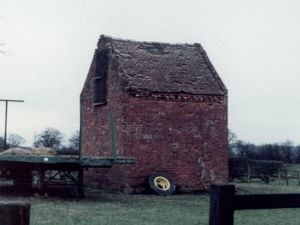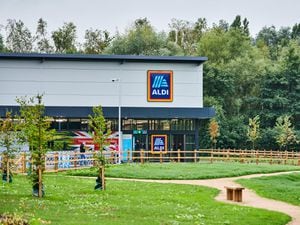The stories behind our best-known statues
The role of statues is in the spotlight. Today we look at figures from our history remembered in stone or bronze.
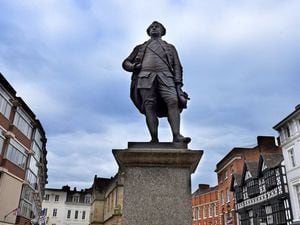
1. Clive of India

In pride of place in The Square, the bronze statue of Robert Clive has been a fixture in Shrewsbury since it was belatedly unveiled on January 18, 1860, many years after his death in 1774.
Born near Market Drayton, he was a humble clerk with the East India Company who rose to become the military commander whose battlefield success cemented British power in India.
He accumulated huge wealth and enemies in equal measure, and faced allegations of bribery and malpractice. Nevertheless in 1773 Parliament declared that he did “render great and meritorious services to his country.”
He became Baron Clive of Plassey. His specific connection with Shrewsbury was that he was the town's MP, and also became the town's mayor.
The circumstances of his death are unclear, but many accounts say he committed suicide.
The statue was funded by a subscriptions committee.
2. Charles Darwin

Born in Shrewsbury, Darwin changed forever the way we perceive our place in the world.
Popular, too. In 2005 he was named as Shropshire’s favourite person of all time following a special internet-based vote by county residents.
Darwin was educated at the old Shrewsbury School, now the main library, and in front of which his statue stands (or rather sits).
He was the first to present detailed evidence about evolution and the way in which species can change through natural selection.
His long voyage as ship's naturalist on HMS Beagle led to his hugely influential book On the Origin of Species, which caused uproar in Victorian society but became accepted as a breakthrough.
The bronze statue of him dates from 1897, which was 15 years after his death. Donated to the town by Shropshire Horticultural Society, which coughed up £1,086 9s 3d, it is a Grade II listed structure, which means it has special protection.
3. Hercules

Poor Hercules in the Quarry in Shrewsbury has had a long and troubled past.
Cast in Rome, until 1804 he stood in front of Condover Hall, before being sold to a Shrewsbury plumber who was going to melt him down, but he was saved and erected close to Shrewsbury jail.
Hercules was later presented to the town and was put up at the entrance to the Quarry, being moved to his present position when the new Quarry gates were erected in 1881.
The early 18th century lead statue has suffered various indignities, including being painted in football colours, daubed with graffiti, having his arms wrenched off, and having his figleaf chopped off by vandals.
A six-month restoration was completed in 2004, complete with figleaf, which the researchers discovered was part of the original casting and not a Victorian addition. Another discovery at the time was that the statue had been filled with cattle bones.
4. Lord Hill
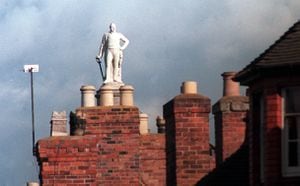
Shropshire's great military hero stands high on his perch on top of the 133ft column near the Shirehall, overlooking Shrewsbury.
Hill made his name in the Peninsular War in a long, bloody, but ultimately successful campaign against Napoleon’s forces in Spain and Portugal.
The ceremony for the laying of the first stone of The Column, paid for by public subscription, was on December 27, 1814, and the last stone was laid in 1816, on the first anniversary of the Battle of Waterloo, where Hill had been the Duke of Wellington's right hand man.
The passing years have not been kind to the 17ft statue, made of Coade stone. From time to time bits have fallen off – an obvious danger – and there have been repeated restorations.
There are moves to raise enough money to replace the crumbling statue with a replica. That's not a new idea either – in 1965 there was talk of replacing Lord Hill with a fibreglass model.
5. Rowland Hill

Sir Rowland was the first Protestant Lord Mayor of London in 1549. He bought Hawkstone in Shropshire and other land nearby in 1556. The monument was erected by a descendant, Sir Richard Hill, in 1795, standing 100ft tall and supporting the statue.
The statue you see there now is a modern one and entirely different from the original which was either struck by lightning or blown down, we think in 1936.
Hawkstone Park fell into disrepair before it was bought and rejuvenated by the Barclay Brothers in the early 1990s.
The Tuscan-style column, which is Grade One listed, was restored and as part of the revamp sculptor Guy Portelli was commissioned to create a new statue of Sir Rowland Hill, which was cast in 1992.
6. Thomas Telford
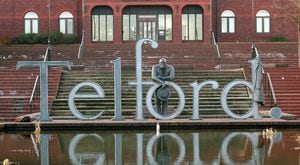
Telford (1757-1834) is the great Scottish civil engineer after whom the town of Telford is named.
As Shropshire's first county surveyor, he is best known for his road and bridge-building projects.
His bronze statue in the town depicts him leaning on the letters of his name and looking out over a pool. It was unveiled on April 8, 1988, in an area then known as the Civic Square.
One of the quirks by sculptor Andre Wallace was to depict Telford's coat hanging from the letter "D" – which fooled the BBC cameraman at the unveiling who thought it was a real coat left on by mistake.
The letters are cast iron and were made at Glynwed at Ketley.
The statue was commissioned by Telford Development Corporation to commemorate the 150th anniversary of the death of Telford, but it ran almost four years late.
Total cost was about £30,000, with over half coming from company donations by the engineering industry.
7. Wilfred Owen

This is one of Shropshire's newest statues, if not the newest, being erected in Cae Glas Park, Oswestry, in 2018, the centenary year of the Great War poet's death.
The only life-size statue of the war poet in the country, it was created by artist and sculptor Tim Turner from Oswestry and was cast at the world-renowned Castle Fine Arts Foundry, in Llanrhaeadr-ym-Mochnant.
Born at Plas Wilmot in Weston Lane, Oswestry, on March 18 1893, Owen was a virtual unknown at the time of his death in action just a week before the end of the First World War.
Today he is seen as one of the greatest English poets of the 20th century.
The statue was commissioned by Oswestry Town Council, which put aside a £40,000 budget for the work.
Owen's family moved to Birkenhead in 1898, the Shropshire connection being renewed in 1907 when they moved to Shrewsbury, his father Tom becoming assistant superintendent at Shrewsbury railway station..
8. John Weale And Billy Cante

It isn't just the great and the good who get sculpted.
The joint statue of 'Joe The Bear' and Billy is in the grounds of the Trinity Hospital in Clun.
John Weale got his nickname because he is reputed to have wrestled with a dancing bear at Knighton fair.
He was one of the most colourful residents in the history of Trinity Hospital, old almshouses which are now retirement apartments.
So when in 1999 it was decided to celebrate a refurbishment by putting up a statue in the grounds of two of the almsmen of yesteryear, Joe the Bear was chosen as one, and another local character and former almsman, Billy Cante (or Cantie) as the other.
Although facts about Joe's life are hard to come by, he was certainly at the almshouses in the 1930s and had a roguish reputation locally.
The sculpture, in Jesmonite, an acrylic polymer, was the work of local sculptress Jemma Pearson.


